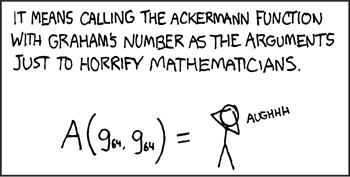39. Ackermann’s Function
⍺ ack ⍵ ←→ f⍢(3∘+) ⍵ ⇒ (⍺+1)ack ⍵ ←→ f⍣(1+⍵)⍢(3∘+) 1
Ackermann’s function is defined on non-negative integers as follows:
ack←{
0=⍺: 1+⍵
0=⍵: (⍺-1) ∇ 1
(⍺-1) ∇ ⍺ ∇ ⍵-1
}
2 ack 3
9
3 ack 2
29
Lemma: If ⍺ ack ⍵ ←→ f⍢(3∘+) ⍵ ,
then (⍺+1)ack ⍵ ←→
f⍣(1+⍵)⍢(3∘+) 1 .
(⍢ is the under operator where f⍢g y ←→ g⍣¯1 f g y .)
Proof: By induction on ⍵ .
| (⍺+1) ack 0 | basis |
| ⍺ ack 1 | definition of ack |
| f⍢(3∘+) 1 | antecedent of lemma |
| f⍣(1+0)⍢(3∘+) 1 | ⍣ |
| (⍺+1) ack ⍵ | induction |
| ⍺ ack (⍺+1) ack ⍵-1 | definition of ack |
| f⍢(3∘+) (⍺+1) ack ⍵-1 | antecedent of lemma |
| f⍢(3∘+) f⍣(1+⍵-1)⍢(3∘+) 1 | inductive hypothesis |
| ¯3∘+ f 3∘+ ¯3∘+ f⍣(1+⍵-1) ⊢3∘+ 1 | ⍢ and ⊢ |
| ¯3∘+ f f⍣(1+⍵-1) ⊢3∘+ 1 | + |
| ¯3∘+ f⍣(1+⍵) ⊢3∘+ 1 | ⍣ |
| f⍣(1+⍵)⍢(3∘+) 1 | ⍢ |
| QED |
Using the lemma (or otherwise), it can be shown that:
0∘ack = 1∘+⍢(3∘+)
1∘ack = 2∘+⍢(3∘+)
2∘ack = 2∘×⍢(3∘+)
3∘ack = 2∘*⍢(3∘+)
4∘ack = */∘(⍴∘2)⍢(3∘+)
5∘ack = {*/∘(⍴∘2)⍣(1+⍵)⍢(3∘+) 1}
From http://xkcd.com/207

Appeared in J
[101,
109]
and in APL
[96].